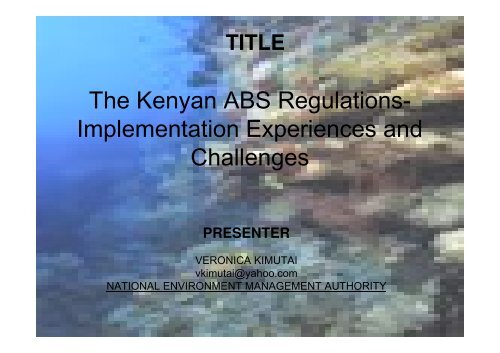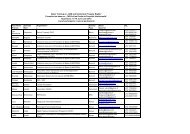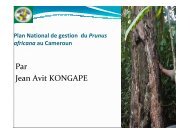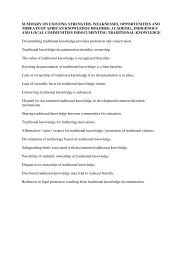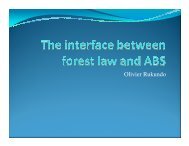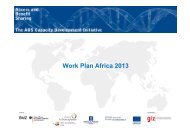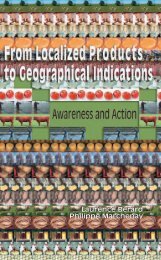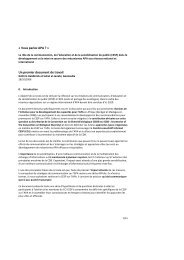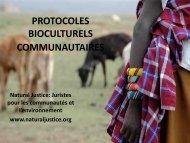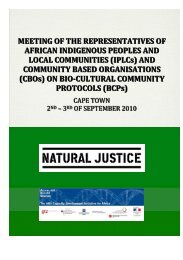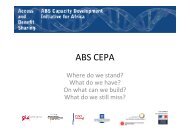The Kenyan ABS Regulations- Implementation Experiences and ...
The Kenyan ABS Regulations- Implementation Experiences and ...
The Kenyan ABS Regulations- Implementation Experiences and ...
You also want an ePaper? Increase the reach of your titles
YUMPU automatically turns print PDFs into web optimized ePapers that Google loves.
TITLE<br />
<strong>The</strong> <strong>Kenyan</strong> <strong>ABS</strong> <strong>Regulations</strong>-<br />
<strong>Implementation</strong> <strong>Experiences</strong> <strong>and</strong><br />
Challenges<br />
PRESENTER<br />
VERONICA KIMUTAI<br />
vkimutai@yahoo.com<br />
NATIONAL ENVIRONMENT MANAGEMENT AUTHORITY
1.0 <strong>The</strong> Environmental Management <strong>and</strong> Co-ordination ordination Act<br />
(1999)<br />
• <strong>The</strong> Environment Management <strong>and</strong> Co-ordination Act is Kenya’s framework<br />
legislation coordinating all environmental management activities in the<br />
country. As such, it constitutes the primary implementing legislation for the<br />
Convention on Biological Diversity. A number of the provisions of the Act have<br />
either direct or indirect potential impacts on the issue of access to genetic<br />
resources.<br />
• Section 42 (3) provides the Minister for Environment with broad powers to<br />
issue orders, regulations or st<strong>and</strong>ards for the management of riverbanks,<br />
lakeshores, wetl<strong>and</strong>s <strong>and</strong> coastal zones.<br />
• EMCA further elaborates the issue on genetic resources more explicitly<br />
through Section 53, which m<strong>and</strong>ates the National Environment Management<br />
Authority (NEMA) to “issue guidelines <strong>and</strong> prescribe measures for the<br />
sustainable management <strong>and</strong> utilisation of genetic resources of Kenya for the<br />
benefit of the people of Kenya.” Accordingly, the provisions of any guidelines<br />
issued or measures prescribed, shall include –
Cont.<br />
a) appropriate arrangements for access to genetic resources of Kenya<br />
including the issue of licenses <strong>and</strong> fees to be paid for that access;<br />
measures for regulating the import or export of germplasm;<br />
b) the sharing of benefits derived from genetic resources of Kenya; <strong>and</strong>,<br />
c) any other matter that the Authority considers necessary for the better<br />
management of the genetic resources of Kenya.<br />
• Sub-section 50(f) of the Environment Management <strong>and</strong> Co-ordination<br />
Act provides that any measure for the conservation of biological<br />
diversity “shall . . . protect indigenous property rights of local<br />
communities in respect of biological diversity<br />
• Pursuant to these provisions, the NEMA has issued the relevant<br />
regulations, namely the Environmental Management <strong>and</strong> Coordination<br />
(Conservation on Biological Diversity <strong>and</strong> Resources,<br />
Access to Genetic Resources <strong>and</strong> Benefit Sharing) <strong>Regulations</strong> 2006.
2.0 Environmental Management <strong>and</strong> Co-ordination<br />
ordination<br />
(Conservation on Biological Diversity <strong>and</strong> Resources,<br />
Access to Genetic Resources <strong>and</strong> Benefit Sharing)<br />
<strong>Regulations</strong> 2006<br />
• <strong>The</strong> Environmental Management <strong>and</strong> Co-ordination (Conservation of<br />
Biological Diversity <strong>and</strong> Resources, Access to Genetic Resources <strong>and</strong><br />
Benefit Sharing) <strong>Regulations</strong> 2006 Legal Notice 160 of 2006, presents the<br />
most comprehensive attempt by the government to date to put in place a<br />
regulatory framework for access to genetic resources <strong>and</strong> benefit sharing.<br />
<strong>The</strong> <strong>Regulations</strong> are set out in five parts.<br />
• Part I addresses preliminary issues, defines the key terms, sets out the<br />
objectives of the regulations <strong>and</strong> sets the scope of application. Access is<br />
defined “obtaining, possessing <strong>and</strong> using genetic resources conserved,<br />
whether derived products, <strong>and</strong>, where applicable, intangible components,<br />
for the purposes of research, bio-prospecting, conservation, industrial<br />
application or commercial use.”
Cont.<br />
• Part II of the <strong>Regulations</strong> provides for the conservation of biological diversity<br />
through the requirement of an environmental impact assessment for<br />
persons who engage in activities that may potentially have an adverse<br />
impact on the environment, propose to introduce exotic species in Kenya or<br />
unsustainable use of natural resources. Further this part provides for the<br />
conservation of threatened species, the inventorying of biological diversity<br />
by NEMA <strong>and</strong> relevant lead agencies, monitoring the status of biological<br />
diversity in Kenya <strong>and</strong> protection of environmentally significant areas.
Cont.<br />
• Part III of the <strong>Regulations</strong> lays out the institutional framework for the<br />
management of genetic resources. It designates NEMA as the competent<br />
authority for all matters relating to access to genetic resources. This part<br />
also attempts to demarcate the responsibilities between NEMA <strong>and</strong> other<br />
lead agencies such as the National Council for Science <strong>and</strong> Technology<br />
which is m<strong>and</strong>ated through the Science <strong>and</strong> Technology Act to issue<br />
clearance for research undertaken in Kenya through a research permit.<br />
<strong>Regulations</strong> 9-17 provides for the application of an access permit, the<br />
requirement for prior informed consent of the government or local<br />
community, the determination of such a permit, validity, terms <strong>and</strong><br />
conditions of the permit <strong>and</strong> the requirement for a register of all access<br />
permits applies for <strong>and</strong> granted by NEMA. Further Regulation 18 specifically<br />
provides that there shall be no transfer of genetic resources outside Kenya<br />
without an access permit <strong>and</strong> Material Transfer Agreement (MTA).
Cont.<br />
• Part IV of the <strong>Regulations</strong>, in particular provides for the principles that apply<br />
for benefit sharing <strong>and</strong> sets out the generic benefits to be shared (monetary<br />
<strong>and</strong> non-monetary) including the participation of <strong>Kenyan</strong> citizens <strong>and</strong><br />
institutions in any activities being conducted with the genetic resources, joint<br />
ownership of patents, payment of access fees <strong>and</strong> royalties. Kenya being a<br />
party to the Convention on Biological Diversity, the principles encapsulation<br />
in this Convention as well as those in the <strong>Regulations</strong> on benefit sharing<br />
constitutes the terms <strong>and</strong> condition for access. Benefit sharing agreements<br />
(MTA) are therefore required to be negotiated prior to the approval of<br />
application <strong>and</strong> the granting of permits to collect <strong>and</strong> obtain genetic<br />
resources.<br />
• Part V of the <strong>Regulations</strong> finally provides for the holding of information as<br />
confidential on application by the applicant for a permit as may be<br />
determined by NEMA in addition to penalties for contravention with the<br />
<strong>Regulations</strong>.
Experience in implementing the <strong>ABS</strong> <strong>Regulations</strong><br />
Slow response in compliance to <strong>ABS</strong> regulations <strong>and</strong> is attributed to lack of<br />
awareness<br />
<strong>The</strong>re has been three (3) inquiries<br />
• Kenya Coffee Research Foundation-wild coffee in Kakamega Forest<br />
• Individual-unspecified plant species in Taita Taveta<br />
• pHD <strong>Kenyan</strong> student at Belgium University-two species of nitrogen fixing<br />
bacteria
4.0 <strong>The</strong> Challenges in implementation <strong>and</strong> Enforcement<br />
Issues under Access to Benefit Sharing<br />
• <strong>The</strong> scope of the application of the regulations are not very clear e.g<br />
Translocation of wild animals from one park to another, does it require access<br />
permit <strong>The</strong> question is, what is actually regulated<br />
• <strong>Regulations</strong> do not expressly cover traditional <strong>and</strong> indigenous knowledge of<br />
the local communities hence it will be difficult for NEMA to safeguard this<br />
knowledge<br />
• Lack of operational tools mentioned in the regulations e.g MTA, MAT <strong>and</strong> PIC<br />
• <strong>The</strong> process of acquiring the access permit is long <strong>and</strong> tedious.<br />
– Requirements-PIC from Community or lead agency<br />
– Research clearance from National Council for Science <strong>and</strong> Technology<br />
– And it takes a maximum of sixty days before one gets a permit<br />
<strong>The</strong> application/access permit fee is quite high <strong>and</strong> is prohibitive especially for students
Cont.<br />
• Lack of capacity in the Biodiversity Section in terms of number of personnel<br />
• Institutional memory/succession not entrenched in the MEAs systems<br />
• Difficulty in enforcement of <strong>ABS</strong> regulations ( nature of biodiversity) <strong>and</strong> monitoring of pemitted<br />
activities.<br />
• Country providing access to genetic resources frequently faces difficulties in monitoring how the<br />
resources are used once they leave the country’s jurisdiction <strong>and</strong> in enforcing compliance with <strong>ABS</strong><br />
rules <strong>and</strong> negotiated terms.<br />
• Studies on experience from other countries e.g South <strong>and</strong> Central American countries indicate that<br />
there is widespread frustration in seeking PIC, negotiating MATs <strong>and</strong> sharing of benefits associated<br />
with the use of genetic resources <strong>and</strong> traditional knowledge due to lack of clear community<br />
infrastructure <strong>and</strong> persons within the community who can negotiate for better terms. Most investors<br />
also dread the PIC requirement due to economic costs. Identifying which community should give<br />
consent is often problematic.
Cont.Challenges<br />
• Institutional conflicts-m<strong>and</strong>ates of some lead agencies overlap with those of<br />
Authority <strong>and</strong> the agencies feel their tasks has been taken away.<br />
• Lack of financial resources to create awareness on <strong>ABS</strong> regulations-Target<br />
groups: lead agencies, research institutions, NEMA field officers, local<br />
communities, administrators
6.0 Recommendations <strong>and</strong> Conclusion<br />
• Continued <strong>and</strong> effective participation of Kenya in regional, <strong>and</strong> international<br />
meetings relevant to <strong>ABS</strong>.<br />
• <strong>The</strong>re is need to build capacity <strong>and</strong> should include the ability to<br />
– Assist communities, private l<strong>and</strong> owners, other organs of the state in the<br />
negotiation of access <strong>and</strong> benefit sharing agreements<br />
– Analyze benefit-sharing agreements <strong>and</strong> underst<strong>and</strong> the provisions they<br />
contain<br />
– Develop an underst<strong>and</strong>ing of opportunities <strong>and</strong> risks associated with bioprospecting<br />
NEMA to develop <strong>ABS</strong> guidelines<br />
• However, it must be noted that <strong>ABS</strong> system will only work in an environment of<br />
well sensitized communities <strong>and</strong> policy makers. Hence NEMA should embark on<br />
comprehensive sensitization exercise at a variety of levels i.e relevant public<br />
institutions, research institutions, local communities etc.


